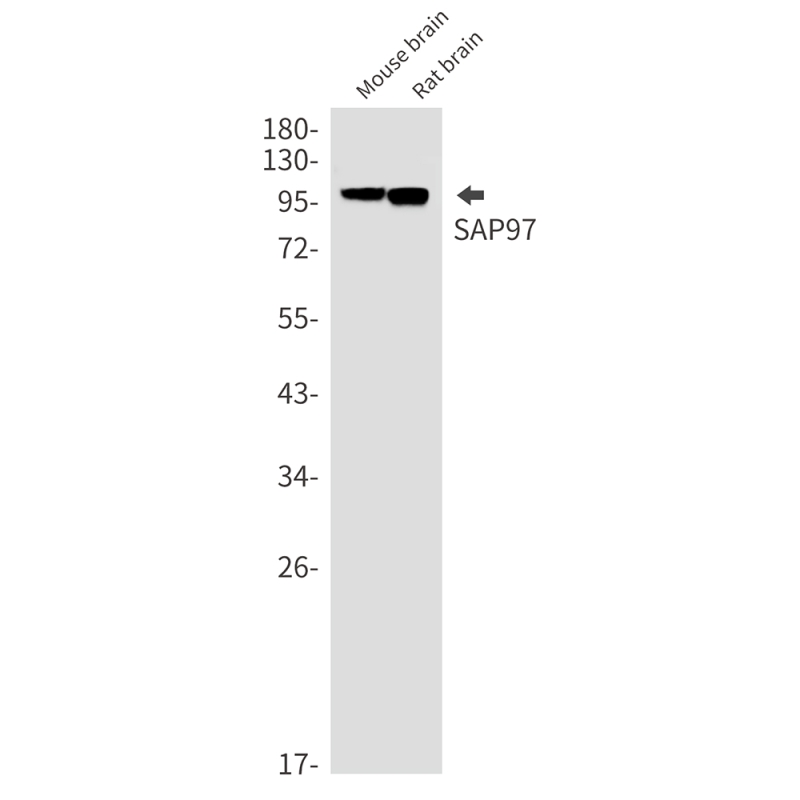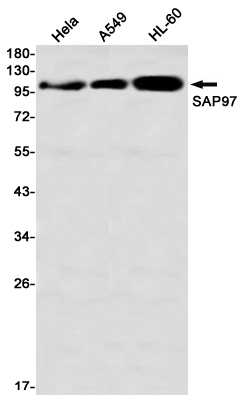

| WB | 1/500-1/1000 | Human,Mouse,Rat |
| IF | 咨询技术 | Human,Mouse,Rat |
| IHC | 咨询技术 | Human,Mouse,Rat |
| ICC | 技术咨询 | Human,Mouse,Rat |
| FCM | 咨询技术 | Human,Mouse,Rat |
| Elisa | 咨询技术 | Human,Mouse,Rat |
| Aliases | DLG1; DLGH1; hDlg; SAP97 |
| Entrez GeneID | 1739 |
| WB Predicted band size | Calculated MW: 100 kDa; Observed MW: 100 kDa |
| Host/Isotype | Rabbit IgG |
| Antibody Type | Primary antibody |
| Storage | Store at 4°C short term. Aliquot and store at -20°C long term. Avoid freeze/thaw cycles. |
| Species Reactivity | Human,Mouse,Rat |
| Immunogen | A synthetic peptide of human SAP97 |
| Formulation | Purified antibody in TBS with 0.05% sodium azide,0.05%BSA and 50% glycerol. |
+ +
以下是关于SAP97抗体的3篇参考文献,涵盖其在神经科学和细胞生物学中的应用:
---
1. **文献名称**:*"SAP97 is associated with the alpha-amino-3-hydroxy-5-methylisoxazole-4-propionic acid receptor GluR1 subunit"*
**作者**:Leonard, A. S., Davare, M. A., Horne, M. C., Garner, C. C., & Hell, J. W.
**摘要**:该研究通过免疫共沉淀和免疫荧光技术,利用SAP97抗体揭示了SAP97蛋白与AMPA受体GluR1亚基的相互作用,证明其在海马神经元突触后膜受体锚定中的关键作用。
---
2. **文献名称**:*"Role of SAP97 in synaptic assembly and function"*
**作者**:Roberts, J. D., & Roche, K. W.
**摘要**:通过Western blot和免疫组织化学实验,使用SAP97抗体证明其在神经元突触形成中的结构功能,并发现其与PSD-95等其他支架蛋白的协同作用,调控突触可塑性。
---
3. **文献名称**:*"Molecular cloning and characterization of SAP97. a novel synapse-associated protein"*
**作者**:Müller, B. M., Kistner, U., & Garner, C. C.
**摘要**:该研究首次克隆SAP97基因并制备特异性抗体,通过免疫印迹和免疫电镜确认其在大脑突触中的高表达,为后续研究提供重要工具。
---
以上文献均涉及SAP97抗体的实验应用,包括蛋白互作分析、亚细胞定位及功能机制研究。
SAP97 (Synapse-Associated Protein 97), also known as DLG1 (Discs Large Homolog 1), is a member of the membrane-associated guanylate kinase (MAGUK) family. It plays a critical role in organizing synaptic structures and regulating receptor trafficking at neuronal synapses, particularly in the postsynaptic density (PSD). Structurally, SAP97 contains PDZ, SH3. and guanylate kinase (GK) domains, enabling interactions with various proteins, including NMDA receptors, AMPA receptors, and potassium channels. These interactions contribute to synaptic plasticity, neuronal signaling, and maintenance of cell polarity.
Antibodies targeting SAP97 are widely used in neuroscience research to study its expression, localization, and function in both physiological and pathological contexts. For example, they help investigate SAP97's involvement in neurodevelopmental disorders (e.g., schizophrenia, autism spectrum disorders) and neurodegenerative diseases (e.g., Alzheimer's). These antibodies are commonly applied in techniques like Western blotting, immunohistochemistry, and immunofluorescence to visualize SAP97 distribution in brain tissues or cultured neurons.
Notably, SAP97 isoforms (α, β, γ) arising from alternative splicing exhibit distinct subcellular localizations, requiring antibody specificity validation for accurate detection. Commercial SAP97 antibodies are typically raised in rabbits or mice using epitopes from conserved regions. Researchers must verify cross-reactivity and batch consistency, as off-target binding to other MAGUK proteins (e.g., PSD-95) can occur. Overall, SAP97 antibodies remain essential tools for unraveling synaptic protein networks and disease mechanisms.
×